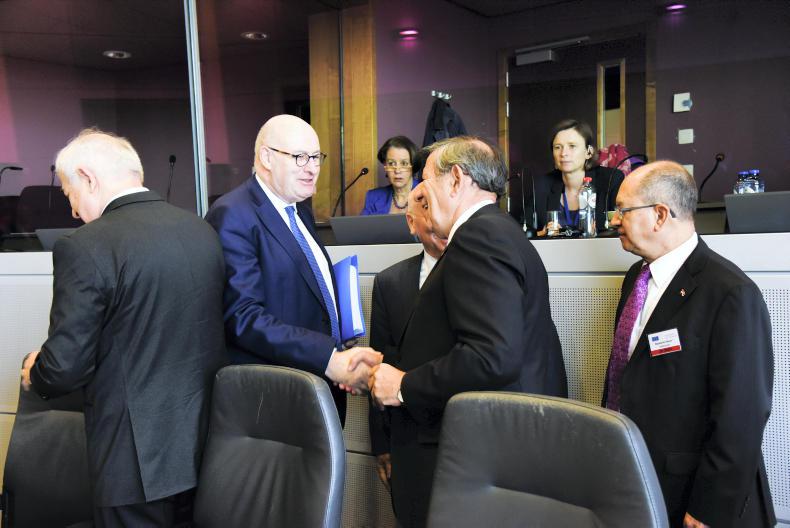Despite intense pressure from the South American countries that make up Mercosur and indeed inside the EU, the agriculture lobby position on further offers on beef and sugar/ethanol is holding. The Irish interest is specifically on beef access where the current offer remains at 70,000t. That position held firm at the trade policy committee (TPC) last Friday.
What has been signalled is that any upward movement on the sensitive issues from the EU side will depend on a big offer from the South Americans on what are described as the EU offensive interests, the products the EU wants to sell to them. These include cars, car parts, pharmaceuticals, other industrial goods and dairy products. So far, the Mercosur side has failed to impress the EU with its offers on these products, but the signals coming out of Brussels are that the EU could move as far as 99,000t, but no further. Reports from South America suggest that it is particularly reluctant to open its market to EU dairy products.
Even 99,000t doesn’t seem to be matching Mercosur expectations, despite the outrage that it would cause with Irish and EU beef producers.
Foro Mercosur De La Carne, the umbrella representative body for 12 meat industry organisation in Mercosur countries, wrote to Mercosur ministers outlining its expectations. In the letter, it called on Mercosur’s negotiators to look for a 100,000t fresh meat quota and a 100,000t frozen quota, with a built-in mechanism that would enable these to grow to 160,000t each.
From the Mercsour angle, 100,000t was on offer back in 2004 and there is a view that the numbers currently being debated aren’t meeting the mandate that was given to the Mercosur negotiators back in 2010 ahead of resumption of the then stalled negotiations.
What’s next?
In a briefing to the International Trade Committee of the Parliament a couple of weeks ago, the EU lead negotiator, Sandra Gallina, said that the negotiations needed political leadership and it was time for heavy lifting. Since then, we had last week’s ministerial in Brussels involving the European Trade and Agriculture Commissioners. There was no major breakthrough there with the Mercosur side departing to reflect. That reflection will be centred on the reality that agriculture has drawn a red line at 100,000t and are not prepared to go that far without a suitable offer on the other side.
Hence, both sides can claim to be correct. The European Commissioner for Agriculture can correctly say the 70,000t offer hasn’t been increased while the Mercosur side is aware that there is flexibility to move up, possibly as far as 99,999t but only if the EU is getting what it wants in return.
What do quotas mean?
The debate so far has concentrated on whether it will be 70,000t or 99,000t of beef that the EU will take from Mercosur in a trade agreement. However, within these numbers there is a huge variation of the level of access. The first is whether it is for frozen manufacturing-type beef or higher-value fresh meat, usually steak meat. In global terms, the EU steak meat market is the most lucrative and therefore the most valued access for external suppliers.
Another issue on which quotas differ is the duty applied. The current Hilton quota, which several countries outside Europe have access to, is at a 21% tariff which though substantial, is well below WTO rates that can be up to 100%. On the other hand, the EU has a “quality beef” quota which is 48,000t tariff-free on a first-come, first-served basis.
Another mechanism for controlling access is having a progressive reduction of tariffs. For example, in the trade deal negotiated between the EU and Japan, the tariff rate will fall from the present 36% to 9% but over a period of 15 years. The objective is that giving greater market access will be progressive, not in a sudden manner and therefore intended to cause minimum disruption to domestic production. There is also a facility to put up a de facto trade barrier in exceptional circumstances to protect the home market. A hard Brexit deal that causes 250,000t of Irish beef to divert from the UK market to the rest of the EU could be one such occasion.
It is waiting time for Irish beef farmers as the Mercosur countries ponder on the limits of the EU offer that isn’t even a formal offer yet. If they aren’t prepared to work with less than 100,000t, as indicated, it is no deal. That would be a big disappointment for DG Trade and would cause ructions in many EU countries but it would be a break that EU and, in particular, Irish beef producers badly need.






 This is a subscriber-only article
This is a subscriber-only article












SHARING OPTIONS: